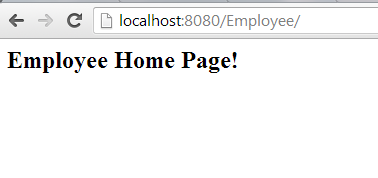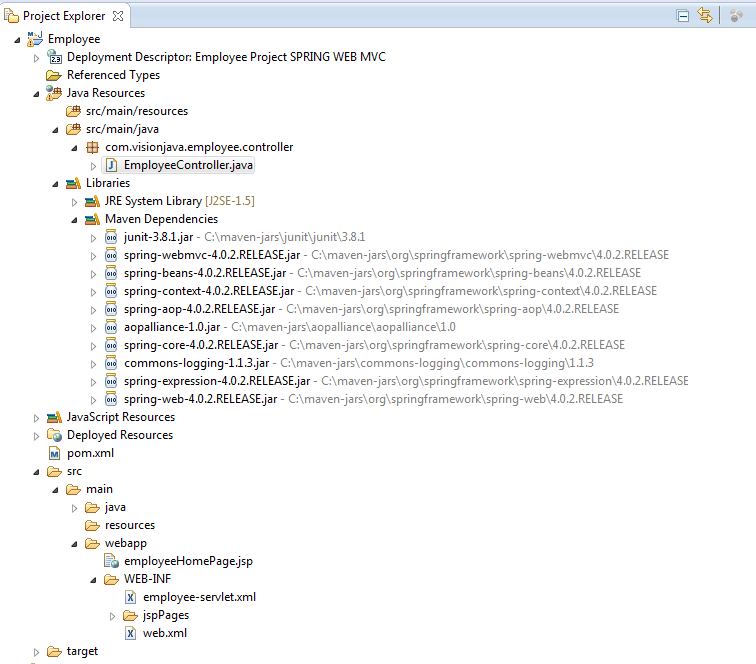NOTE: Source Code available for download at the bottom of the page
We will develop a Spring Web MVC based web application and deploy it on tomcat server. To keep the project simple, we will just display the homepage. We will also examine what is required and how things work in Spring Web MVC.
What's needed?
Overall design
Let's get started.
End Output:
Setup Eclipse Project
Create a dynamic web project using maven artifact "maven-archetype-webapp" as shown HERE.
Following Steps summarize the process for creating the Spring MVC project.
Step 1: Update POM file to get dependencies for Spring Web MVC
For Spring Web MVC jars
pom.xml
<dependency> <groupId>org.springframework</groupId> <artifactId>spring-webmvc</artifactId> <version>4.0.2.RELEASE</version> </dependency>
Step 2: Add declaration for Spring DispatcherServler servlet in web.xml.
web.xml
<!DOCTYPE web-app PUBLIC "-//Sun Microsystems, Inc.//DTD Web Application 2.3//EN" "http://java.sun.com/dtd/web-app_2_3.dtd" > <web-app> <display-name>Employee Project SPRING WEB MVC</display-name> <servlet> <servlet-name>Employee</servlet-name> <servlet-class>org.springframework.web.servlet.DispatcherServlet</servlet-class> <init-param> <param-name>contextConfigLocation</param-name> <param-value> /WEB-INF/employee-servlet.xml </param-value> </init-param> </servlet> <servlet-mapping> <servlet-name>Employee</servlet-name> <url-pattern>/</url-pattern> </servlet-mapping> </web-app> <servlet-mapping> for Employee forwards all the requested url's to servlet named Employee <servlet> declaration for Employee is defined as Spring DispatcherServlet. Upon initialization of a DispatcherServlet, Spring MVC looks for a file named [servlet-name]-servlet.xml in the WEB-INF directory of your web application and createsthe beans defined there, overriding the definitions of any beans defined with the same name in the global scope.If you want to name the context file with name different than [servlet-name]-servlet.xml , you can use
to define the location and file name.
Step 3: Create Web Application Context file.
employee-servlet.xml
<?xml version="1.0" encoding="UTF-8"?> <beans xmlns="http://www.springframework.org/schema/beans" xmlns:xsi="http://www.w3.org/2001/XMLSchema-instance" xmlns:mvc="http://www.springframework.org/schema/mvc" xmlns:context="http://www.springframework.org/schema/context" xsi:schemaLocation=" http://www.springframework.org/schema/mvc http://www.springframework.org/schema/mvc/spring-mvc-3.0.xsd http://www.springframework.org/schema/beans http://www.springframework.org/schema/beans/spring-beans-3.0.xsd http://www.springframework.org/schema/context http://www.springframework.org/schema/context/spring-context-3.0.xsd"> <context:annotation-config /> <context:component-scan base-package="com.visionjava" /> <mvc:annotation-driven /> <bean id="viewResolver" class="org.springframework.web.servlet.view.InternalResourceViewResolver"> <property name="cache" value="true" /> <property name="prefix" value="/WEB-INF/jspPages/" /> <property name="suffix" value=".jsp" /> <property name="redirectHttp10Compatible" value="false" /> </bean> </beans> <context:annotation-config /> is used to activate annotations in beans already registered in the application context. Ex: @Autowired, @Resource, @Required, @PostConstruct <context:component-scan base-package="com.visionjava" /> scans the defined packages and registers the beans with application context(like controller, bean). <mvc:annotation-driven /> declares explicit support for new Spring MVC features like @Valid, @RequestBody, @RequestResponse etc. <bean id="viewResolver" class="org.springframework.web.servlet.view.InternalResourceViewResolver"> provides access to controller for the jsp pages under WEB-INF folder. It's a good practice to put all the jsp pages under WEB-INF folder to avoid giving direct access.
Step 4: Create Controller
package com.visionjava.employee.controller; import org.springframework.stereotype.Controller; import org.springframework.web.bind.annotation.RequestMapping; @Controller public class EmployeeController { @RequestMapping("/") public String showHomePage(){ return "employeeHomePage"; } }
@Controller -- declares the class as Spring Controller type class.
@RequestMapping("/")-- Annotation for mapping web requests onto specific handler classes and/or handler methods.In our case the homepage request is handled by this controller. The return value is resolved by the view resolver which appends the location and suffix for the string.
Step 5: Create JSP Page
employeeHomePage.jsp
<html> <body> <h2>Employee Home Page!</h2> </body> </html>
Project Structure:
|


